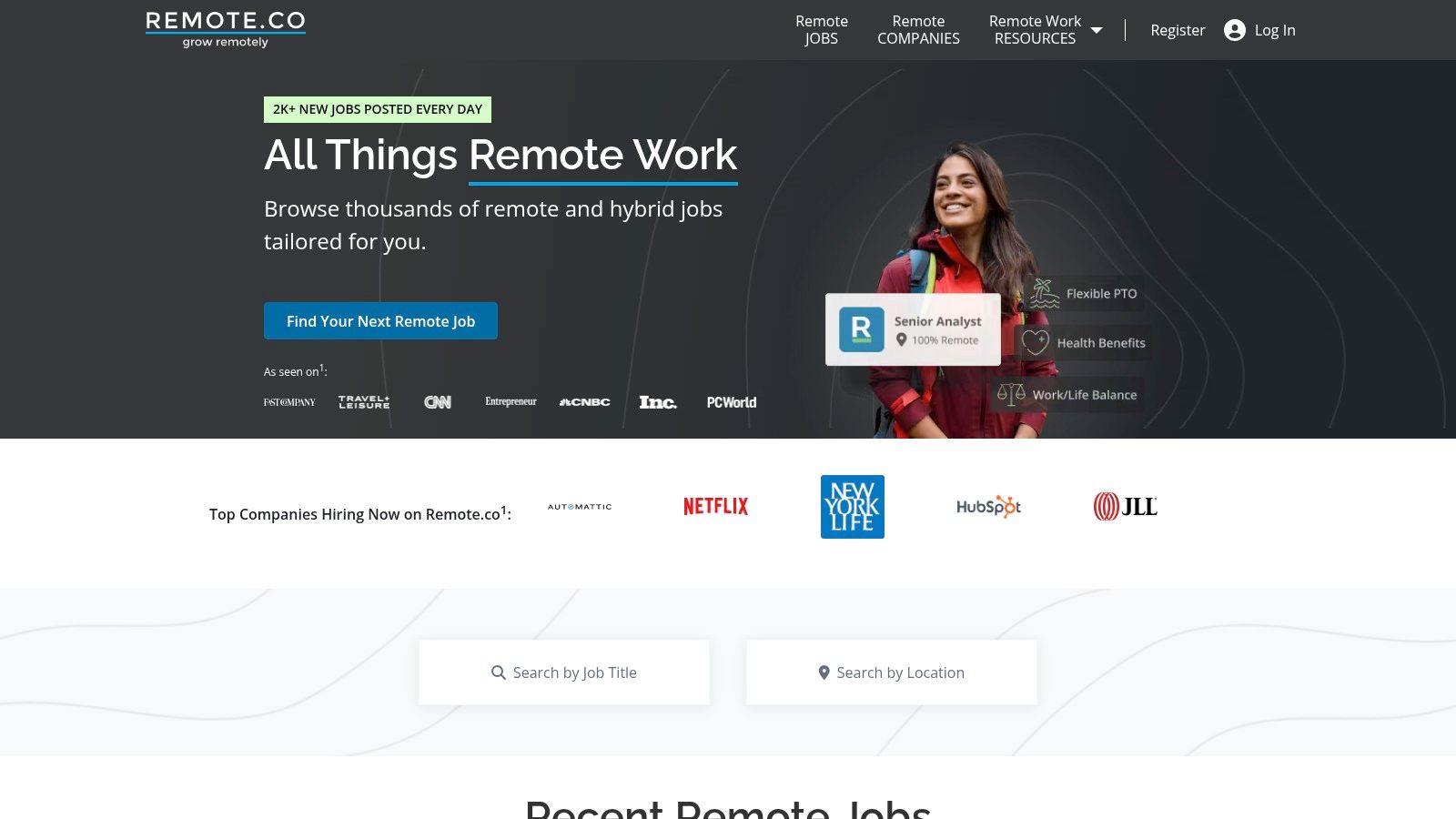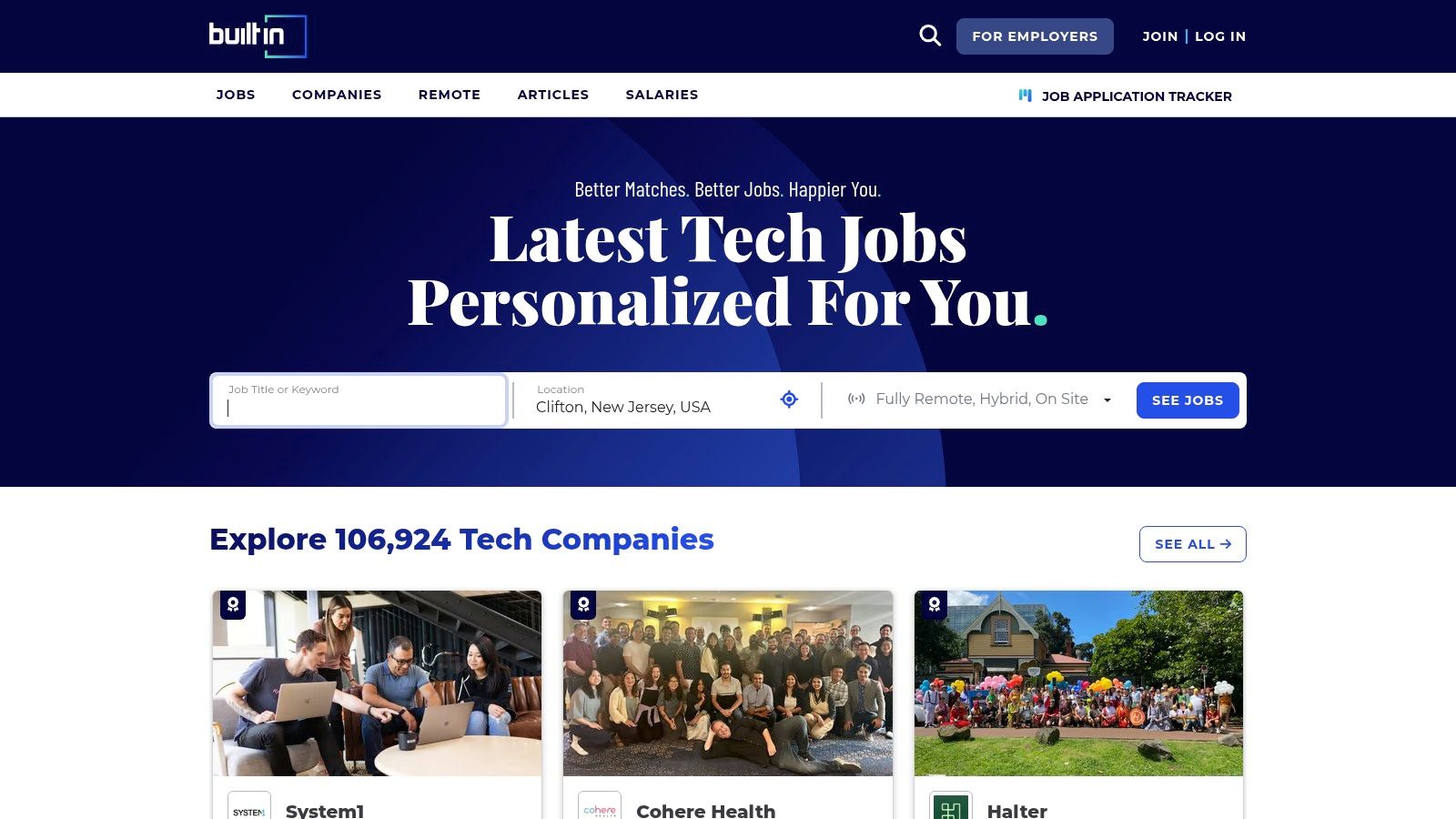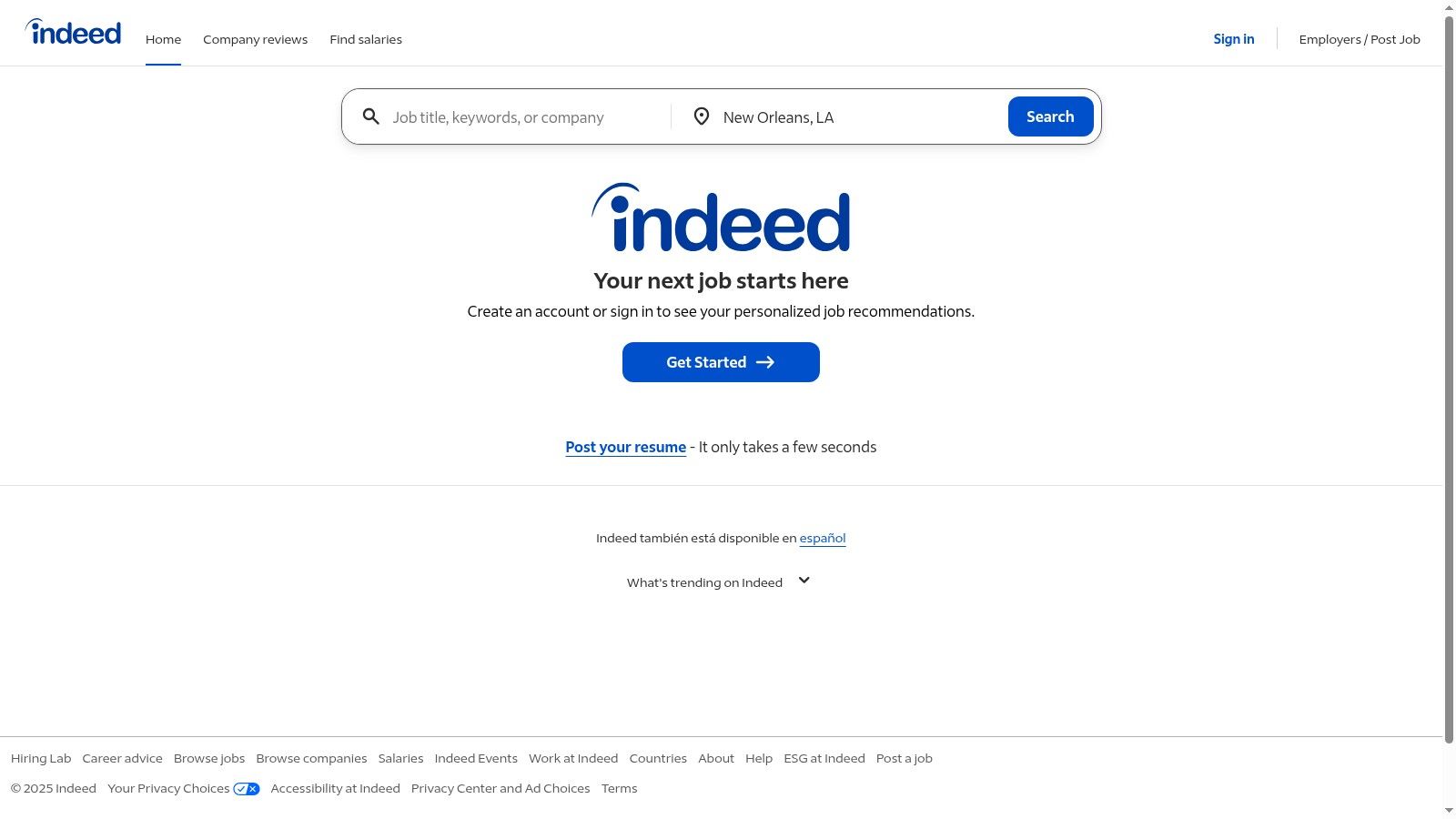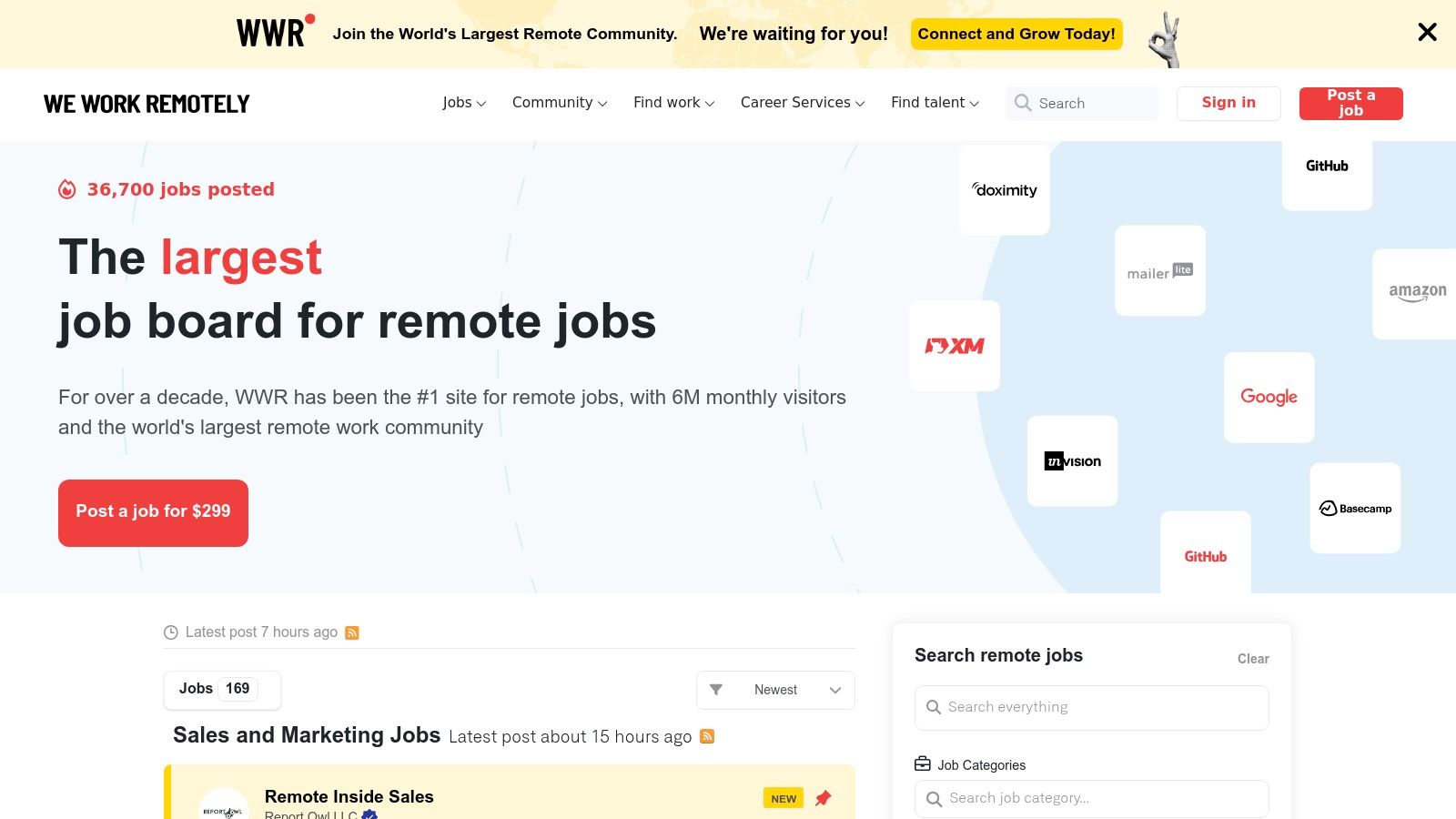7 Best Companies to Work For From Home in 2025: A Deep Dive
Max
The landscape of work has fundamentally shifted, and the demand for flexible, remote-first roles is higher than ever. But with so many options, how do you identify the truly best companies to work for from home? It’s not just about a paycheck; it’s about finding an organization that champions a healthy work-life balance, offers robust benefits, and fosters a supportive virtual culture. This guide cuts through the noise, providing a curated roundup of seven leading platforms and resources where you can discover and connect with top-tier remote employers in 2025.
We’ll delve into what makes each company stand out, their unique cultural aspects, and practical tips on how to position yourself for success. For those aspiring to join these organizations, understanding successful operational models provides valuable insights into effective remote structures; learning how Mergify built a successful asynchronous company can offer a blueprint for what to look for in a great remote employer. Each entry in our list includes screenshots and direct links to help you start your search immediately. This comprehensive overview is designed to streamline your job hunt and connect you with your next great opportunity.
1. FlexJobs
FlexJobs is an essential starting point for anyone serious about finding legitimate remote work. Unlike massive job aggregators where spam and outdated listings are common, FlexJobs distinguishes itself with a human-centric, quality-first approach. Every single job posting on the platform is hand-screened by a real person to verify its legitimacy, saving you countless hours of sifting through questionable opportunities. This meticulous curation makes it a premier resource for discovering the best companies to work for from home.
The platform is designed to be a comprehensive career hub, not just a job board. Beyond its high-quality listings, it offers a robust suite of tools designed to help you succeed in your remote job search. These resources are invaluable for both new and experienced remote professionals looking to sharpen their skills and present themselves effectively to top employers.
Key Features and Offerings
FlexJobs provides a multi-faceted approach to support your career journey. The user interface is clean and intuitive, making it easy to filter jobs by category, flexibility level (100% remote, hybrid, etc.), and location.
- Vetted Job Listings: Access to thousands of professional remote and flexible jobs across over 50 career categories, all guaranteed to be legitimate.
- Annual ‘Top 100’ List: Each year, FlexJobs analyzes its extensive database to release a list of the top 100 companies that have hired the most for remote positions, providing a data-backed roadmap for your search.
- Career Development Tools: Members gain access to expert-led webinars, skills tests, resume reviews, and personalized career coaching to enhance their job-seeking strategy. If you’re new to this work style, you can discover more about the advantages of remote employment.
How to Use FlexJobs Effectively
To get the most out of the platform, a paid membership is required, although they often offer trial periods. This subscription model is what funds their research and screening team, ensuring the high quality of the listings.
| Pros | Cons |
|---|---|
| High signal-to-noise ratio due to vetted listings | Full access requires a paid membership |
| Data-driven research on leading remote employers | Fewer listings than massive, free job boards |
| Comprehensive career resources and support tools |
Pro-Tip: Don’t just browse. Use FlexJobs’ advanced search filters to create and save multiple targeted job alerts. This ensures you’re immediately notified when a role matching your specific criteria and skills is posted, giving you a competitive edge.
Website: https://www.flexjobs.com
2. Remote.co
Remote.co is a powerful resource for job seekers aiming to connect directly with companies that have fully embraced remote work. Operated by the same team behind FlexJobs, it functions as a highly focused job board and content hub dedicated exclusively to remote opportunities. This specialization is its greatest strength, offering a curated environment where every listing comes from an organization that is already committed to a distributed workforce. This makes it an ideal platform for finding the best companies to work for from home without the noise of hybrid or location-specific roles.
The platform goes beyond simple job listings by providing rich insights into the world of remote work. It features in-depth Q&As with leading remote companies, articles on best practices, and tips for managing a remote career. This content helps you understand the culture and operational style of potential employers before you even apply.

Key Features and Offerings
Remote.co is designed for efficiency, helping you quickly identify and engage with legitimate remote-first companies. The user interface is straightforward, prioritizing job discovery and employer insights.
- Remote-Only Focus: The platform exclusively lists remote jobs, saving you the effort of filtering out on-site or hybrid positions.
- Employer Spotlights: Gain valuable insights through detailed Q&As with founders and hiring managers from top remote companies, offering a glimpse into their culture and values.
- Fresh Job Feed: A constantly updated feed showcases recent remote job postings, primarily targeting US-based roles across diverse categories like IT, marketing, and customer success. For more guidance, you can explore this detailed list of the best companies for remote jobs.
How to Use Remote.co Effectively
The platform is free to use, making it an accessible tool for all remote job seekers. Unlike its sister site FlexJobs, there is no membership fee required to view or apply for jobs.
| Pros | Cons |
|---|---|
| Direct access to remote-first and remote-friendly companies | Smaller job volume compared to massive aggregators |
| Free to browse and apply for all job listings | Some roles may be hybrid or outside the US, requiring filtering |
| Valuable employer insights through Q&As and content |
Pro-Tip: Use the “Companies” section to research organizations before you apply. Reading their Q&A profiles gives you specific details you can mention in your cover letter or interview, showing you’ve done your homework and are genuinely interested in their remote culture.
Website: https://remote.co
3. Built In
Built In is a powerful resource for tech professionals seeking to identify and compare the best companies to work for from home. While it functions as a job board, its true value lies in its data-driven annual reports and detailed company profiles. It excels at providing transparent, in-depth looks into the culture, perks, and remote work policies of thousands of employers, particularly within the tech and startup ecosystems.
The platform’s annual “Best Places to Work” awards are a standout feature, with dedicated lists for remote-first companies segmented by size. This allows you to easily discover and vet top-tier remote employers that match your scale preference, from nimble startups to established large enterprises. Each award-winning company profile is rich with information, offering a clear picture of what it’s like to work there before you even apply.

Key Features and Offerings
Built In provides a unique blend of editorial content and actionable job listings, making it a go-to for culture-conscious job seekers. The site is free to use, allowing unrestricted access to its valuable employer data and job application portals.
- Annual ‘Best Remote Places to Work’ Lists: Curated and data-backed rankings highlight top remote employers, categorized by company size (startup, midsize, and large) for easy browsing.
- Detailed Company Profiles: Go beyond a simple job description. These pages detail specific benefits, perks, diversity and inclusion initiatives, tech stacks, and employee testimonials.
- Integrated Job Board: Alongside company profiles and award lists, you’ll find up-to-date job openings, allowing you to apply directly to companies you’ve researched and vetted on the same platform.
How to Use Built In Effectively
Leverage the platform not just for applying, but for strategic research. Use the “Best Places to Work” lists as a starting point to create a target list of companies that align with your values and career goals.
| Pros | Cons |
|---|---|
| Up-to-date, remote-specific award lists | Primarily focused on tech and startup sectors |
| Transparent comparison of employer perks and benefits | Fewer listings for non-technical roles like creative |
| In-depth company culture insights |
Pro-Tip: When viewing a company profile, pay close attention to the “Perks & Benefits” section. Built In standardizes this data, making it incredibly easy to compare health insurance plans, remote work stipends, and PTO policies across multiple potential employers side-by-side.
Website: https://builtin.com
4. LinkedIn Jobs
LinkedIn Jobs transcends the traditional job board by integrating a powerful search engine into the world’s largest professional network. This dual functionality makes it an indispensable tool for discovering remote opportunities and connecting directly with the people who post them. Its vast ecosystem allows you to not only find listings but also to research company cultures, follow industry leaders, and engage with content that showcases the best companies to work for from home.
The platform leverages its massive user base to provide a dynamic and interactive job-seeking experience. Instead of just applying into a void, you can build relationships with recruiters, get referrals from your network, and gain insights into a company’s inner workings directly from current employees. This networking component is what sets LinkedIn apart, turning a passive search into an active career-building strategy. When exploring job platforms, it’s insightful to consider the underlying infrastructure and how companies like LinkedIn manage to serve such a vast user base, demonstrating the impressive scale and reach of LinkedIn.
Key Features and Offerings
LinkedIn’s features are designed to provide a 360-degree view of the job market. The user interface is familiar to anyone on the platform, with powerful filters that allow for precise targeting of remote and hybrid roles across any industry imaginable.
- Advanced Remote Job Filters: Easily narrow your search to “Remote,” “Hybrid,” or “On-site” roles, and set up real-time job alerts to be notified the moment a relevant position is posted.
- Rich Company Pages: Go beyond the job description by exploring company pages that feature employee testimonials, cultural insights, recent posts, and a list of alumni from your school.
- Direct Networking: Connect with hiring managers, recruiters, and team members at your target companies to ask questions, seek referrals, and increase your application’s visibility. This is a key advantage offered by many of the top remote job websites.
How to Use LinkedIn Jobs Effectively
While the core job search is free, LinkedIn Premium offers features like InMail credits and applicant insights that can enhance your strategy. The free version remains incredibly powerful if used correctly.
| Pros | Cons |
|---|---|
| Massive volume of roles across all industries | Some noise and lower-quality listings |
| Powerful integration of job search and networking | Key features are behind a Premium paywall |
| Rich data and insights on companies and roles |
Pro-Tip: Optimize your LinkedIn profile with keywords relevant to your target remote roles before you start applying. A well-crafted profile acts as a magnet for recruiters who actively use the platform to source candidates for unlisted positions.
Website: https://www.linkedin.com/jobs
5. Indeed
Indeed is one of the world’s largest job aggregators, and its immense scale makes it a powerful tool for discovering remote opportunities. While it’s known for its sheer volume of listings, Indeed has evolved to provide more targeted resources for remote job seekers. The platform leverages its vast data to offer valuable insights, including editorial research and user-generated reviews, helping you identify the best companies to work for from home based on real employee experiences.
Its key strength lies in combining a massive job inventory with robust filtering and employer data. This allows you to not only find remote roles but also vet potential employers by looking at their ratings, salary data, and overall employee wellbeing scores. This integrated approach saves time by keeping your search and research within a single ecosystem.

Key Features and Offerings
Indeed provides a suite of tools that go beyond simple job searching, helping you make more informed career decisions. Its interface allows for quick filtering by “remote” location, salary, and job type, streamlining the initial discovery phase.
- Extensive Remote Listings: Access millions of work-from-home job postings across virtually every industry and career level, all searchable through a dedicated remote filter.
- Employer Reviews and Ratings: Gain insights from current and former employees about company culture, management, and work-life balance, which is crucial for evaluating remote-first environments.
- Editorial ‘Best Of’ Lists: Indeed’s editorial team frequently publishes data-driven articles, such as lists of top-rated companies for remote work, based on user satisfaction and wellbeing metrics. If you want to refine your search strategy, you can get more tips on how to find remote jobs.
How to Use Indeed Effectively
Indeed is free for job seekers, as its business model is funded by employers. To maximize your efficiency, create a detailed profile and upload your resume to enable “Easy Apply” options, which significantly speed up the application process.
| Pros | Cons |
|---|---|
| Enormous volume of job listings across all sectors | Signal quality can vary; requires users to vet listings |
| Free to use for job seekers | The “Easy Apply” feature can lead to a high volume of applicants |
| Integrated employer reviews and salary data |
Pro-Tip: Set up multiple, highly specific job alerts for remote roles. For example, create one for “Remote Marketing Manager” and another for “Work From Home Content Strategist” with desired salary ranges. This ensures you receive tailored notifications and can apply quickly to the most relevant openings.
Website: https://www.indeed.com
6. We Work Remotely (WWR)
We Work Remotely (WWR) is a pioneering platform in the remote work landscape and stands as one of the largest and most respected remote-only job boards. Its core philosophy is simple: connect talented individuals with opportunities that aren’t confined by geography. WWR has cultivated a reputation for high-quality, legitimate listings, making it a trusted destination for professionals seeking roles at the best companies to work for from home.
Unlike broader job sites, WWR’s exclusive focus on remote work creates a targeted and efficient search experience. The platform is more than just a listing service; it’s a community hub offering resources, events, and a popular Slack channel where remote professionals can connect and share insights. This community-centric approach helps job seekers feel supported throughout their career journey.

Key Features and Offerings
WWR provides a streamlined yet powerful set of tools for finding your next remote role. The site is known for its clean interface and strong emphasis on quality over quantity, with popular categories including engineering, marketing, design, and customer support.
- Remote-Only Job Listings: Every position is 100% remote, eliminating the need to filter out hybrid or location-specific roles. Advanced search filters help you narrow down opportunities quickly.
- Community Slack Channel: Gain access to a vibrant community of over 17,000 members to network, ask questions, and share experiences about the remote work lifestyle.
- Remote Career Resources: The site publishes insightful content, including annual “State of Remote Work” reports and guides that offer valuable data and trends for job seekers.
How to Use We Work Remotely Effectively
WWR is completely free for job seekers to browse and apply for positions, making it highly accessible. Employers pay a fee to post, which helps fund the platform’s moderation and ensures a level of seriousness from the companies listing roles.
| Pros | Cons |
|---|---|
| Completely free to browse and apply | Lower volume of roles compared to mega job boards |
| Strong anti-scam moderation policy | Application process sometimes redirects to third-party sites |
| Community focus supports long-term remote careers |
Pro-Tip: Engage with the WWR Slack community. It’s an excellent place to get direct advice from seasoned remote workers, learn about companies from the inside, and even hear about unadvertised opportunities before they hit the main job board.
Website: https://weworkremotely.com
7. Remote OK
Remote OK is a high-traffic, real-time job board that has become a go-to resource for tech-focused remote professionals. Its core strength lies in its massive, continuously updated inventory of remote roles, primarily in programming, design, sales, and support. The platform’s no-nonsense interface prioritizes speed and volume, making it an excellent tool for job seekers who want a broad view of the current remote market. By charging employers to post and boost their listings, it also ensures a higher degree of intentionality from the hiring companies.
The platform is known for its transparency, often highlighting jobs with publicly listed salaries, which helps candidates quickly assess opportunities. It also provides regional filters, allowing users to narrow their search to specific areas like the ‘United States’ or ‘North America’, which is crucial for roles with location or time-zone requirements. This focus on clear, relevant data helps job seekers efficiently find roles with some of the best companies to work for from home.

Key Features and Offerings
Remote OK focuses on delivering a large volume of high-quality, tech-centric remote jobs with an emphasis on transparency. The user interface is straightforward, designed for quick browsing and filtering to find relevant opportunities fast.
- Extensive Job Inventory: A vast and frequently updated list of roles across popular remote fields like programming, design, marketing, and customer support.
- Geographic and Role Filters: Easily filter jobs by specific tags (e.g., “Full-Stack,” “Senior”) or by geographic regions, such as North America, to find roles that fit your location needs.
- Salary Transparency: Many listings prominently display salary ranges, empowering you to make informed decisions before applying. This is a key step before you start building your home office.
How to Use Remote OK Effectively
Remote OK is completely free for job seekers, as its revenue comes from companies paying to post their openings. While the platform offers helpful anti-scam guidance, it’s important to remember that many listings link out to external company sites, so always perform your own due diligence on potential employers.
| Pros | Cons |
|---|---|
| Large inventory and frequent updates with easy alert setup | Aggregated posts may link off-site, requiring external navigation |
| Clear anti-scam warnings and application guidance | Requires users to vet the legitimacy of employers themselves |
| Many postings include salary information upfront | Primarily focused on tech and digital roles |
Pro-Tip: Leverage the platform’s powerful tagging system. Instead of generic searches, combine multiple tags like “Senior,” “React,” and “North America” to create highly specific job feeds and email alerts that deliver the most relevant opportunities directly to your inbox.
Website: https://remoteok.com
Top 7 Remote Job Platforms Comparison
| Platform | Implementation Complexity 🔄 | Resource Requirements ⚡ | Expected Outcomes 📊 | Ideal Use Cases 💡 | Key Advantages ⭐ |
|---|---|---|---|---|---|
| FlexJobs | Moderate: paid membership needed for full access | Medium: subscription cost + time for research | High-quality, vetted remote job leads | Professionals seeking spam-free, curated remote roles with career support | Curated, hand-screened listings; annual top employer list; member resources |
| Remote.co | Low: free access, simple interface | Low: mostly browsing and filtering jobs | Reliable discovery of remote-first companies | Job seekers targeting US-based remote/hybrid roles | Frequent fresh job updates; employer spotlights; remote work content |
| Built In | Moderate: browsing segmented lists | Low to Medium: free access, some focused on tech | Insightful company comparisons and direct applications | Candidates wanting remote roles in tech/startups with benefits info | Detailed company profiles; segmented remote-first rankings |
| LinkedIn Jobs | Moderate to High: extensive filters + networking | Medium to High: time investment, Premium optional | Vast job reach with networking leverage | Wide-ranging professionals seeking remote roles across industries | Largest job volume; direct recruiter contact; premium filters |
| Indeed | Low: free access, large aggregator | Low: self-service search and alerts | High-volume applications with employer insights | Job seekers valuing quantity and broad sector coverage | Massive job database; salary and employer reviews |
| We Work Remotely | Low: free, straightforward browsing | Low: no membership required | Access to vetted remote-only job postings | Remote workers wanting free access to frequent, moderated listings | Strong anti-scam policies; community and educational resources |
| Remote OK | Low: free browsing, easy alerts setup | Low: no subscription, user-driven alert setup | Fast updates on large variety of remote jobs | Candidates seeking up-to-date roles with regional filtering | Large, frequently updated inventory; open salary info; anti-scam guidance |
Your Next Step to a Fulfilling Remote Career
Embarking on the search for your ideal remote position can feel like navigating a vast, digital landscape. The journey, however, becomes significantly more manageable when you’re equipped with the right tools. We’ve explored a powerful set of platforms, each offering a distinct advantage in uncovering the best companies to work for from home. From the meticulously vetted and scam-free environment of FlexJobs to the tech-centric communities on Built In and the sheer volume of opportunities on Indeed, your search strategy is now multi-faceted and robust.
The key takeaway is that a one-size-fits-all approach no longer suffices. The modern remote job seeker must be agile, leveraging multiple platforms to gain a holistic view of the market. Your goal is not just to find a remote job, but to find the right one, a role that aligns with your skills, career goals, and desired work-life integration.
Crafting Your Personalized Job Search Strategy
To truly maximize your efforts, consider creating a personalized strategy that combines the strengths of these platforms. Here’s a practical approach to get you started:
- For Curated Quality: Begin with platforms like FlexJobs and We Work Remotely. Their focus on high-quality, verified listings saves you precious time filtering out irrelevant or low-quality posts. This is your foundation for finding serious, remote-first employers.
- For Niche and Tech Roles: If you’re in the tech industry, dedicate specific time to searching on Built In and Remote OK. These platforms attract companies that understand and value technical talent, often offering more competitive compensation and cutting-edge projects.
- For Networking and Brand Insights: Use LinkedIn not just for job alerts, but as an intelligence-gathering tool. Follow target companies, connect with employees, and engage with posts to understand their culture. This research is invaluable for tailoring your application and preparing for interviews.
- For Comprehensive Coverage: Use Indeed and Remote.co as your broad-net tools. Their vast databases ensure you don’t miss any opportunities, but be prepared to apply more rigorous filtering to find the hidden gems.
Beyond the Application: Preparing for Remote Success
Securing a role at one of the best companies to work for from home is only the beginning. The transition to a fully remote environment requires a proactive mindset and a new set of operational skills. As you start working with teams distributed globally, practical competencies become just as important as your core job functions.
For instance, effective communication and coordination are paramount. A common challenge is aligning schedules with colleagues in different parts of the world. Learning how to master scheduling meetings across time zones is a valuable skill that demonstrates your readiness for a global, asynchronous work environment and helps you make a strong impression from day one.
Ultimately, your success hinges on a strategic search and a commitment to adapting to the unique demands of remote work. The perfect role is out there, waiting for a candidate who is not only qualified but also prepared to thrive in a distributed team. Use the insights from this guide, tailor your approach, and take that confident next step toward building a fulfilling and flexible career.
Ready to cut through the noise and accelerate your search? Remote First Jobs aggregates and verifies thousands of high-quality remote opportunities from top companies, so you can spend less time searching and more time applying. Find your next remote role today!


